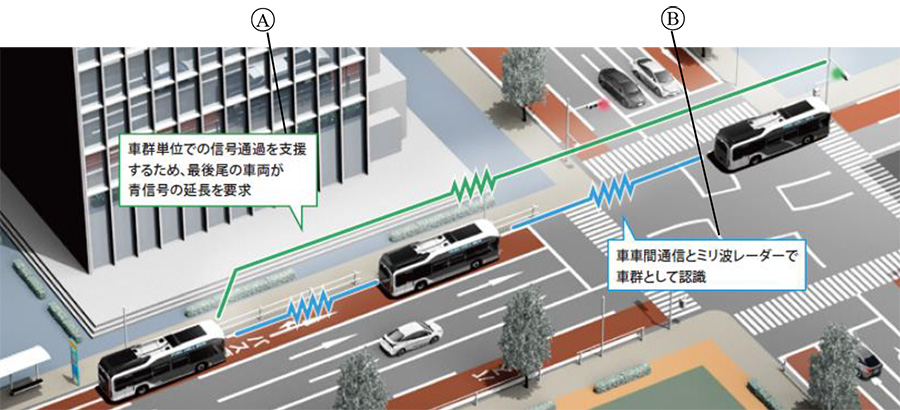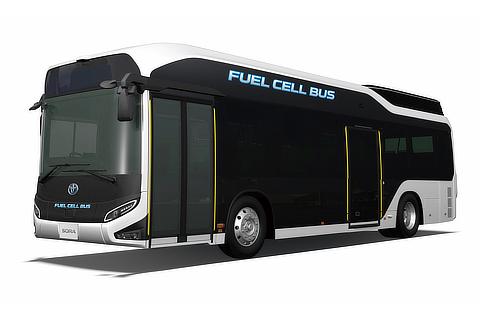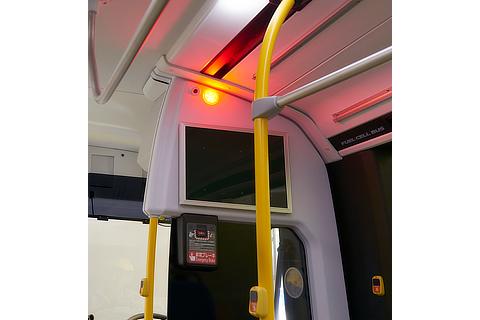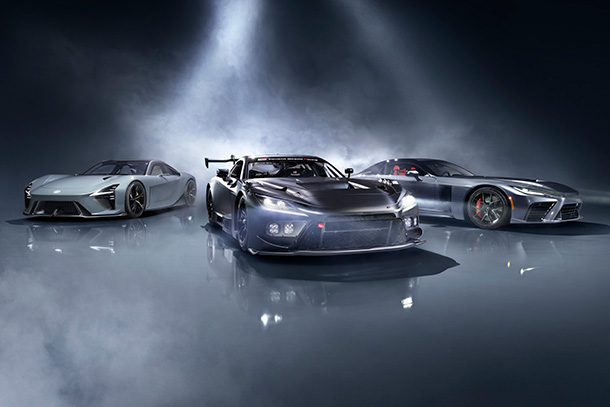Aug. 06, 2019
Toyota Improves Preventive Safety Performance of "Sora" Fuel Cell Electric Bus in Japan
Toyota City, Japan, August 6, 2019―Toyota Motor Corporation (Toyota) announces today the launch of its updated "Sora1" Fuel Cell Electric Bus in August and improvements to its preventive safety performance. Specifically, Toyota has improved the Sora's preventive safety performance through the use of ITS functions (ITS: Intelligent Transport Systems). Additionally, the Sora's transportation capacity, speed, and punctuality have been expanded.
-

- "Sora" Fuel Cell Electric Bus
As a public transport bus, the Sora requires both a high operation rate and high safety performance at all times. To this end, the updated model includes a function that cautions the driver when making right turns at intersections, and a system that enables passengers to activate an emergency stop in urgent situations, such as if the driver suddenly falls ill.
The updated Sora is equipped with a new system that shares information on the distance between the vehicles, to prevent two or more buses traveling in a convoy from being separated at traffic lights and bus stops, leading to overall improvements in transportation capacity, speed, and punctuality of the buses.
The improvements2 made in this update are listed below.
Preventive Safety Functions
- ITS Connect Vehicle-to-Infrastructure Communication System (DSSSDriving Safety Support Systems)
Infrastructure devices and vehicles share information on oncoming vehicles, pedestrians, and traffic lights to increase driver awareness.
- Right-turn Collision Caution
When turning right at an intersection, the system activates an alert to indicate potential hazards for the driver, such as oncoming vehicles or pedestrians on the road. - Red Light Caution
When approaching a red light at an intersection, the system activates an alert if the driver does not ease off the accelerator or if the driver does not see the red light. - Red Light Deceleration Assist
When approaching an intersection and stopping for a red light is likely, the system encourages early deceleration. - Signal Change Advisory
In order to prevent delayed starts, a screen displays the remaining time until the traffic light changes.
-
-

- Right-turn Collision Caution
-
-
-

- Red Light Caution
-
-
-

- Red Light Deceleration Assist
-
-
-

- Signal Change Advisory
-
- Emergency Driving Stop System (EDSS)
If an urgent situation occurs, such as the driver suddenly falling ill, this system allows the driver or passengers to press the emergency brake switch to decelerate the bus and bring it to a stop3. The control system has been designed specifically for public transport buses, where the safety of standing passengers is crucial. As the bus starts to decelerate, red flashing lights and a voice alert passengers to the emergency; those outside the vehicle and nearby are alerted to the emergency via a horn and flashing stop lights and hazard lights.
-

- Passenger switch
-

- Driver's seat switch
-

- Red flashing lights (Driver's seat partition part)
-

- Red flashing lights (Upper part of entrance door)
- Collision Warning System
If the millimeter-wave radar installed at the front of the bus detects there is a risk of colliding with a vehicle or obstacle ahead on the road, it alerts the driver with a warning buzzer and activates a warning notification on the monitor screen. The system considers the safety of standing passengers and seated passengers who have not fastened their seatbelts, and supports the driver in avoiding collisions by assisting with steering.
Transportation Capacity
- ITS Connect Vehicle-Convoy Information Service
The service uses information on buses, bus order, and distance between buses traveling in a convoy to prevent the convoy from being separated at traffic lights and bus stops; this contributes to improved transportation capacity, speed, and punctuality.
- Vehicle-Convoy Recognition Function
Using vehicle-to-vehicle communications and millimeter-wave radars, the system recognizes information―within the limits of maximum bus numbers for any given section―on the buses, bus order, and distance between buses traveling in convoy, and notifies drivers of the convoy size.
-

- Image of Vehicle-Convoy Recognition Function and Radar-type PTPS with Vehicle-Convoy Function
- In order to ensure that the entire convoy can pass through a set of traffic lights at the same time, the last bus in the convoy sends a request to the traffic lights to remain green for an extended period of time.
- Vehicle-to-vehicle communications and millimeter-wave radars are used to recognize the formation of a vehicle convoy.
- Bus Stop-Start Information System
This system recognizes when customers board and alight from buses traveling in convoy, and helps ensure the entire convoy leaves the bus stop at the same time.
- ITS Connect Communicating Radar Cruise Control
The buses are equipped with all-speed radar cruise control, which supports smooth acceleration and deceleration. If a preceding vehicle is also equipped with communicating radar cruise control, the bus uses information shared via vehicle-to-vehicle communications to respond rapidly to the acceleration and deceleration of the preceding vehicle, which enables the buses to follow smoothly. The system also contributes to the maintenance of a constant inter-vehicle distance when traveling in a convoy on dedicated bus roads4, and to the stable driving speed of the vehicles that follow.
Speed and Punctuality
- ITS Connect Wave-Type Public Transportation Priority System with Convoy Function
Using dedicated ITS radio, the system sends requests to infrastructure devices to extend green light times or reduce red light times. When traveling in a convoy, the last bus in the convoy sends a request to extend the green light time, thereby reducing the risk of the convoy from being separated by a red light.
Barrier-free
- Automatic Arrival Control System (Optional)
The system detects guidance lines on the road surface and automatically steers and decelerates the bus, causing the bus to stop at the designated boarding and alighting location, and minimizing the gap to the bus stop itself. This assists boarding and alighting for passengers using strollers or wheelchairs.
-

- Image of automatic arrival control system
Main specifications
| Vehicle | Name | Sora |
|---|---|---|
| Length / width / height | 10,525 / 2,490 / 3,350 mm | |
| Capacity (seated passengers, standing passengers, and driver) | 79 (22 + 56 + 1) | |
| FC stack | Name (type) | Toyota FC Stack (solid polymer electrolyte) |
| Maximum output | 114 kW × 2 (155 PS × 2) | |
| Motor | Type | AC synchronous |
| Maximum output | 113 kW × 2 (154 PS × 2) | |
| Maximum torque | 335 N・m × 2 (34.2 kgf・m × 2) | |
| High-pressure hydrogen tank | Number of tanks (nominal working pressure) | 10 (70 MPa) |
| Tank internal volume | 600 liters | |
| Drive battery | Type | Nickel-metal hydride |
| External power supply system5 | Maximum output / power supply amount | 9 kW / 235 kWh |
| 1 | Soraan acronym for Sky, Ocean, River, Air, representing the earth's water cycle. |
|---|---|
| 2 | Among newly added functions, Emergency Driving Stop System was developed by Hino Motors Limited. Collision Warning System, Automatic Arrival Control, ITS Connect Vehicle-to-Infrastructure Communication System, and ITS Connect Communicating Radar Cruise Control were jointly developed by Hino Motors Limited. and Isuzu Motors Limited. Vehicle-Convoy Information Service and ITS Connect Wave-Type Public Transportation Priority System with Vehicle Convoy Recognition Function were jointly developed by these two companies and Toyota. |
| 3 | This system conforms to the Ministry of Land, Infrastructure, Transport and Tourism's "Emergency Driving Stop System" technological guidelines. |
| 4 | Dedicated bus roads are for the use of public transport buses only, and other types of vehicles are prohibited from using them. Dedicated bus roads differ from standard bus lanes, which other types of vehicles are prohibited from using by law, except when making right or left turns. |
| 5 | The power that can be supplied and the power amount may differ, depending on the performance of the power supply unit, amount of hydrogen remaining, and power consumption. External power output device sold separately. |











